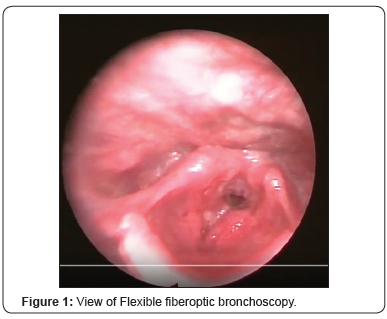Abstract
Awake intubation is one of the strategies which planned according to situation of the patient, surgical procedure, the skill of the anaesthetist, the patient has difficult airway. Flexible fiberoptic bronchoscopy (FOB) is the golden standard for difficult airway patients. Airway reflexes can be removed by performing superior laryngeal nerve block (SLNB) and glossopharyngeal nerve block. Sedation is needed in this procedure to reduce anxiety and adverse events. We report a case that awake intubation assisted with FOB was performed with a bilateral glossopharyngeal nerve block and ultrasound-guided bilateral SLNB who had a difficult airway, scheduled for direct laryngoscopy.
Keywords: Coronary arterial; Anaesthetist; Glossopharyngeal nerve; Glottis; Fibreoptic intubation; Midezolam
Abbrevations:FOB: Flexible Fiberoptic Bronchoscopy; SLNB: Superior Laryngeal Nerve Block; COPD: Chronic Obstructive Pulmonary Diseases; SLN: Superior Laryngeal Nerve
Case History
The patient was 66 years old, male, smoker (1 box a day for 50 years). He has COPD (Chronic obstructive pulmonary diseases) nearly 30 years and story of coronary arterial diseases. He planned for direct laryngoscopy. İn pre-operative assessment the patient has shortness of breath, hoarseness, cough, phlegm and hemoptysis. Because of a lesion that keeps being more on right vocal cord continuous on anterior commissure, left vocal cord and filled right ventricule holding both band ventricules also extend in the posterior subglottic area about 2cm, the opening of rima glottis was only 5mm. Due to a potentially difficult airway, the anaesthetic plan was to perform an awake fibreoptic intubation. We decided to perform glossopharyngeal and superior laryngeal nerve block to anaesthetise for awake intubation.
% Midezolam, 2mg and remifentanyl, 50μg were administered intravenously, and than infusion of remifentany(0.25μg/kg/h) was administered intravenously. Block of the lingual branch of the glossopharyngeal nerve was performed using 60mg of lidocaine 2% in a syringe with a needle 22 × 32 mm. The tongue was retracted medially, and the needle was inserted under the mucosa at the base of the pillar, 0.5cm lateral to the base of the tongue 30mg lidocaine were injected in each side. A portable ultrasound machine (USG 6-13MHz linear probe, Logiq e, General Electric, USA) was brought to the operating room. We scanned neck of patient using with ultrasound. Hyoid bone was easily identified in the transverse plane and prope rotated to sagittal plane. SLN was seen below the level of great hyoid horn. 1ml of 2% lidocaine were injected by A 22 gauge needle under ultrasound guidance in an in-plane configuration. This process was applied to the other side and consequently bilateral superior laryngeal nerve (SLN) was blocked. Endotracheal tube(diameter: 5.0mm) passed easily through the vocal cords without triggering a cough reflex, airway compromise rises in blood pressure and heart rate. Correct placement of the endotracheal tube was confirmed with the fiberscope, capnography and auscultation. General anaesthesia was started. Direct laryngoscopy and biopsy performed successfully.
Discussion
Fiberoptic intubation of the spontaneously breathing patient is the gold standard and technique of choice for the elective management of a difficult airway (Figure 1).

With SLBN lingual radiks, epiglottis, cricoideal muscule anaesthesia can be achived so cough, retching and straining reflexes eleminated. During awake intubation in patients, sedation is used to relieve anxiety, induce amnesia, eliminate pain and blunt protective reflexes (e.g. cough). Opioids and benzodiazepines are administered intravenously; their doses should be suitably adjusted to avoid excessive sedation and apnoea, which may be life threatening in difficult airway cases. The findings of recent studies demonstrate that remifentanil usage during fibreoptic intubation shortens the procedure and provides higher comfort [1]. Recently, ultrasound guided can be useful and altrenative to identify and assist for superior laryngeal nerve block in patients undergoing awake FOB intubation [2]. This technique can provide good visual information on the anatomy. The potential advantages of using ultrasound imaging for nerve blocks include reduction in the amount of local anaesthetic required, improved success rate, reduced time to perform the block and reduced complication rate [3]. In this case, use of ultrasound made it possible to perform a superior larengeal nerve block with low dose local anaesthetic without complications (bleeding, hematoma, failure block, accidental injection).
Result
Awake entubation can be performed after performing SLBN and glossofrangeal nerve block with fiberobtic broncoscopy in patients have difficult airway.
To Know More About Journal of Case studies Please
Click on:
https://juniperpublishers.com/jojcs/index.php
To Know More About Open
Access Journals Publishers Please Click on: Juniper
Publishers




Hi,
ReplyDeleteWe read each and everything as per written in your post. Thank you for this article because it’s really informative, I love reading your blog.
Regards,
Ultrasound guided Injection in Bexleyheath